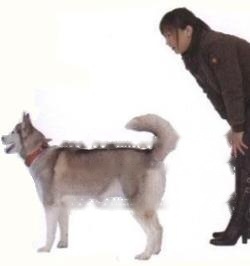Dogs Bladder stones can irritate the urethral mucosa and cause urethral mucosal damage, so the dog will experience hematuria, dysuria, and frequent urination. If left untreated, over time, stones can completely block the urinary tract. So how can you tell if a dog has bladder stones? What are the symptoms of bladder stones in dogs and how to treat them?

ChineseShar Pei
dog Bladder stones will stimulate the urinary tract mucosa, causing damage to the urethral mucosa, so the dog will appear hematuria, dysuria, frequent urination and other phenomena. If left untreated, over time, stones can completely block the urinary tract. So how can you tell if your dog has bladder stones?
Urine tests, X-rays can be used to diagnose uroliths, urinary tract tumors, polyps, blood clots, and urinary tract infections. Urogenital abnormalities were identified. Symptoms associated with stones are not specific to uroliths. There are various methods for estimating urolith composition, such as macroscopic observation, crystalluria, radiological imaging, and quantitative analysis of stones, which provide definitive diagnostic information.
After being diagnosed with bladder stones in my pet, most of the stones in the bladder are already very large or many! At this time, the best time for conservative treatment is lost, and the urethral obstruction is serious Most patients have surgery on the same day to remove the stone.
When a dog's bladder stone is formed, the stone in the dog's bladder will move to the ureter, which can cause ureteral blockage, and a small amount of stone can be excreted in the urine. Due to the stimulation of the stone, it is easy to cause damage to the mucous membrane of the canine urinary tract, causing inflammation, bleeding and other symptoms.
Bladder and urethral calculi in male dogs often occur at the same time, and the main symptoms are difficulty urinating, frequent urination, and blood in the urine. Dogs urinate hard and groan. In the early stage, a small amount of urine can be excreted, and the urine is dripping. Completely unable to discharge, fine sand-like stones can be felt at the foreskin. As the disease progresses, the dog develops abdominal distension, and the bladder can be felt full and enlarged when the abdomen is touched. Poisoning by the urine, the dog performance polydipsia, vomiting and other symptoms. Eventually, he dies from complications from a ruptured bladder. Most of the female dogs are bladder stones, which are manifested as frequent urination at the initial stage, cloudy urine with viscous or fibrous flocs, or blood in the discharged urine, and severe hematuria. Some showed pain response during urination, less urine output and more frequent. Some can discharge small particles or fine sand-like stones during urination. For larger and more calculous stones, while standing and holding down, use both hands to touch the upper part of the abdominal cavity and the front of the hip tubercle to touch the hard and full bladder with slight mobility.
If you do not pay attention to the observation of bladder stones in dogs, it will be difficult to find them in the early stage. Therefore, it is very important to pay more attention to the dog daily. If your dog has reached the level of needing surgery, then as an owner, you must pay attention to some precautions before and after surgery.
When the male dog's urethra cannot be conducted, first cut the urethra to drain the urine. According to the probing of the catheter and the external palpation of the hand to feel the obstruction of the urethra, after determining the obstruction site, the skin on the ventral side of the foreskin is shaved and disinfected. Hold the penis bone in your left hand to lift the foreskin and penis, tensioning the skin. Make a 2-4 cm incision in the midline between the back of the penis bone and the yin, cut the skin, separate the subcutaneous tissue to expose the constrictor muscle of the penis and move it to the side, cut the corpus cavernosum, and use a catheter to indicate the urethral calculus. Make a longitudinal incision of 1-2 cm in the urethra at the site of the stone, and carefully remove the stone from the incision with a blunt curette. Then the catheter is advanced until it enters the bladder, and the urine in the bladder is drained as much as possible at this time to facilitate cystotomy. After ensuring patency of the urethra, the incision is irrigated and the urethra is sutured with catgut. The skin nodules are sutured with silk thread.
The skin incision is a 6-8 cm incision on the foreskin side one finger width parallel to the penis. After the skin is incised, the foreskin edge of the incision is pulled laterally to expose the white line of the abdominal wall. The abdominal wall is incised at the linea alba, and care should be taken to avoid damage to the abdominal wall blood vessels and bladder. After exposing the bladder, hold the base of the bladder with one or two fingers, carefully turn the bladder out of the incision so that the dorsal side of the bladder is upward, then isolate the bladder with gauze, and probe with fingers to check for cystitis and bladder wall thickening. Make an incision in the direction of smooth muscle from the dorsal part of the bladder with few blood vessels. When a finger is inserted into the incision, it is generally possible to detect stones of different sizes in the bladder neck. A small spoon and intravesical irrigation can be used to remove the stone residue as much as possible. If the small stones cannot be completely removed, the backwash method can be used to remove the stones. The method is as follows: after the catheter is inserted from the urethra into the urethra and passed through the penis bone, the normal saline with ampicillin and warm water is injected into the urethra to flush the urethra until the stones are completely backwashed into the bladder, and the incision is made through the incision of the cyst. until discharged. After the bladder stones were removed and cleaned, the bladder incision was closed with double-layer continuous inversion suture. In order to prevent the sutures from being exposed in the bladder and becoming the inducement of stone formation, Cushing's suture was used for the first layer, and horizontal mattress varus suture was used for the seromuscular layer of the bladder wall; The muscle layer was sutured with continuous inversion vertical mattress suture, and absorbable catgut was used for the suture. After the bladder was returned to the abdominal cavity, the abdominal cavity was routinely closed. Male dogs stay catheterized for 5 to 7 days.
![[Dog Training 5] The training method of pet dog dining etiquette](/static/img/12192/12192_1.jpg)




